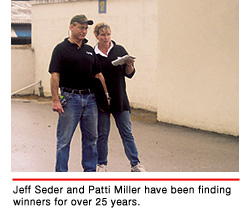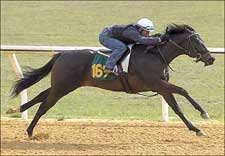Solid Horsemanship
 All great horsemen share one key attribute: masterful powers of observation.
All great horsemen share one key attribute: masterful powers of observation.By opening new doors of observation through science and technology, EQB became a potent competitive advantage in the racing industry. In the process, our groundbreaking research in equine biomechanics, cardiovascular characteristics, gait analysis, and fatigue curve analysis led us to rigorously evaluate more Thoroughbreds than any other entity in the world.
conformation analysis
As a trainer, jockey, and farm manager, EQB’s conformation specialist Patti Miller has worked with outstanding Thoroughbred racehorses all her life.
She performs EQB’s conformation analysis at sales the good old-fashioned, traditional way — as well as from slow-motion digitized videos and computer biometric and biomechanical analyses.
Traditional horsemanship skills enable her to assess how a horse is literally, physically put together and compare it both to the good horses of the past and the ones that had no ability and/or got injured.
Certain conformation flaws can be managed through thoughtful training. Some flaws, such as when a horse is back-at-the-knee, can be further examined using a veterinarian or gait analysis (e.g., where horses are filmed with slow-motion photography while galloping 14 seconds per furlong or faster).
| Only EQB combines traditional conformation assessment with advanced video and computer analysis to see how a horse is literally, physically put together — and how it compares to exceptional horses of the past. |
pedigree analysis
We can and do provide our clients with full pedigrees and their interpretation. But we can also do more.
The old maxim that “blood will tell” can now be advantageously updated to “DNA will tell.” Specifically, EQB possesses the databases to go beyond merely linking pedigree to historical race records, as well as the statistical tools to go beyond simply finding anomalous patterns, or nicks, in that data. Beyond revealing a family’s racing success and physical characteristics, we can determine if — and to what extent — the statistical patterns actually mean something.
After all, the very best pedigree work still only conveys the probabilities of what a horse will be like physically, and because long shots do happen, it always remains best to actually look at the horse itself.
veterinarian selection
It is nearly impossible to overstate the value of priority access to a smart, experienced, and honest racehorse veterinarian — especially one that a) you trust, b) you’ve dealt with frequently before, c) who values your ongoing business, d) is current on the latest technologies and e) is accessible at every major auction venue.
We wouldn’t operate otherwise — and, thanks to relationships with some of the industry’s most distinguished veterinarian talent, we never do.
Remember: Most horses at select sales have reasonable conformation, so this measure alone is a relatively weak predictor of success in the racing world.



